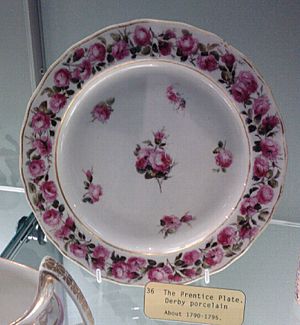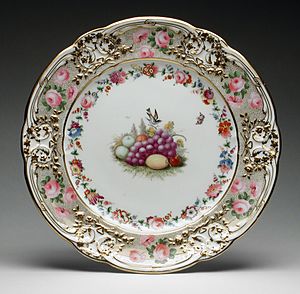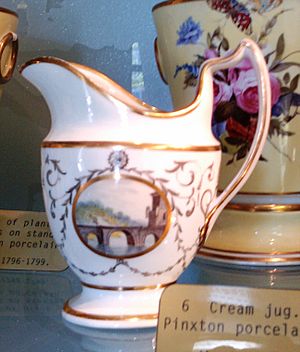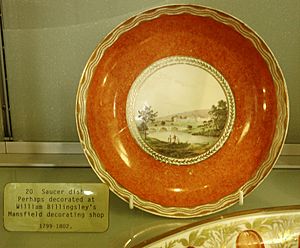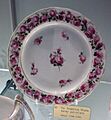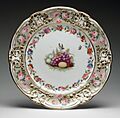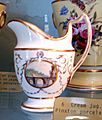William Billingsley (artist) facts for kids
Quick facts for kids
William Billingsley
|
|
|---|---|
| Born | 1758 |
| Died | 1828 |
| Nationality | British |
| Known for | painting porcelain |
William Billingsley (1758–1828) was a very important artist who painted porcelain in England. He worked at several famous factories. He also created his own special recipe for a type of porcelain called soft-paste porcelain. This porcelain looked beautiful, but it was very difficult to make without breaking during the firing process.
Billingsley is well-known for his unique style of painting flowers on porcelain. His art is often called "naturalistic" because the flowers looked so real. He learned his skills in his hometown of Derby. Even though his work was sold in London, he mostly stayed in the Midlands and South Wales. These areas were the main places for making porcelain in Britain back then.
He made his special porcelain at Pinxton and later at the Nantgarw Pottery. He started the Nantgarw Pottery in 1813 with his son-in-law. Before that, he spent over 20 years at Derby porcelain. He also worked at Worcester porcelain and finished his career at Coalport porcelain.
Contents
William Billingsley's Life Story
Early Life and Training
William Billingsley was born in Derby in 1758. When he was 16, he started an apprenticeship at William Duesbury's Royal Crown Derby porcelain factory. This training lasted for five years. He stayed at Derby until 1796, becoming their best flower painter. Flower designs were very popular on porcelain at that time.
Billingsley developed a special way of painting flowers. He would put a lot of paint on his brush, then use a dry brush to remove some of the color. This gave his paintings a unique look. He was especially known for painting borders of roses. A famous example is the Prentice Plate. This plate was used at the Derby factories to show new trainees the high quality of work they needed to achieve. The name Prentice Plate is a shorter way of saying Apprentice Plate.
Moving to New Factories
In 1795, Billingsley decided to leave Derby. The factory's London agent, Joseph Lygo, tried to convince the owner to keep him. Lygo said Billingsley was too valuable to lose. He worried that Billingsley would share his painting style with other factories. After working at Derby for 22 years, Billingsley moved around a lot for the rest of his career. He worked at many different potteries.
Pinxton and Porcelain Experiments
First, he went to Pinxton, a small village in Derbyshire, in October 1795. There, he helped set up the Pinxton factory with John Coke. Billingsley was very interested in making a better recipe for soft-paste porcelain. He wanted his porcelain to be even more beautiful than the famous Sèvres porcelain from France.
At this time, most English factories were starting to use a new type of porcelain called bone china. Sèvres also stopped making soft-paste porcelain around 1806. Billingsley stayed at Pinxton until 1799. The Pinxton factory continued until 1813, possibly just decorating blank porcelain pieces made elsewhere. Today, Pinxton porcelain is rare and very valuable.
More Moves and New Connections
After Pinxton, Billingsley moved to Mansfield. There, he only ran a workshop for painting. Around 1802 or 1803, he moved to Torksey, Lincolnshire. Some people believe he made porcelain there, and also in the nearby village of Brampton. It was likely here that he met Samuel Walker, a potter. Samuel Walker later married Billingsley's daughter, Sarah, in 1812.
Another pottery he supposedly started was in Wirksworth, Derbyshire, between 1804 and 1808. Before settling at Worcester, Billingsley looked for work at several potteries. This included the Cambrian Pottery in Swansea, Glamorganshire, in 1807.
The Nantgarw Pottery
Billingsley started working at Royal Worcester in 1808. He helped the company improve their porcelain recipe. While at Royal Worcester, he signed a contract promising not to share their porcelain recipes. However, the contract did not stop him from making his own porcelain.
In 1813, Billingsley took his porcelain recipes and his many years of experience. He moved to Nantgarw, Glamorganshire, Wales, with his daughter Lavinia and his son-in-law Samuel Walker. There, he started the Nantgarw Pottery.
Starting the Factory
Nantgarw Pottery began in November 1813. Billingsley and Walker rented "Nantgarw House" and built kilns and other equipment. They turned the house into a small porcelain factory. They had £250 to invest in their project. By January 1814, a businessman named William Weston Young became the main investor. Young likely knew Billingsley through a friend, Thomas Pardoe, whom Billingsley had met in Swansea. Young, who worked as a surveyor, might have suggested the Nantgarw location to Billingsley.
Challenges and Changes
The pottery was set up, but Billingsley and Walker had a problem. About 90% of their porcelain broke during firing. They quickly ran out of money. They asked the government for a grant, like the one the French government gave the Sèvres Porcelain Factory. They did not get the grant. However, a porcelain fan named Sir Joseph Banks suggested that Lewis Weston Dillwyn from the Cambrian Pottery in Swansea should visit.
Dillwyn saw how much money they were losing. But he was very impressed with the beautiful pieces that did survive. He offered Billingsley and Walker a place at the Cambrian Pottery to improve their recipe. They worked there from late 1814. They made the recipe better, but it was still too wasteful. So, Dillwyn stopped the project.
In 1817, Billingsley, his younger daughter Lavinia, and Samuel Walker returned to Nantgarw. Sadly, Sarah, Billingsley's older daughter and Samuel's wife, had died in January that year. Lavinia also died in September. William Weston Young invested in the pottery again. He also became an art teacher to earn more money.
Billingsley and Walker continued to make porcelain at a loss. Then, in April 1820, while Young was away, Billingsley (known locally as Mr. Beeley) and Walker left for Coalport porcelain. They left behind the pottery lease and many unfinished porcelain pieces.
Later Years and Legacy
Billingsley worked for the Coalport Porcelain Works until he died in 1828. Samuel Walker also worked at Coalport. Later, he moved to America and started the Temperance Hill Pottery in West Troy, New York.
Today, many of Billingsley's porcelain pieces are part of the collection at the Derby Museum and Art Gallery. The Nantgarw pottery has been saved by a group called the "Friends of Nantgarw," formed in 1993. It is now a museum with a growing display of porcelain. The museum has even started making porcelain again using Billingsley's original soft-paste porcelain recipe.
Images for kids


